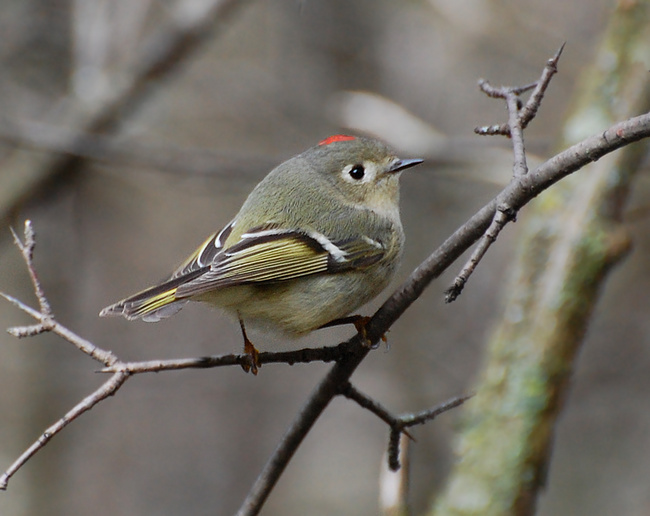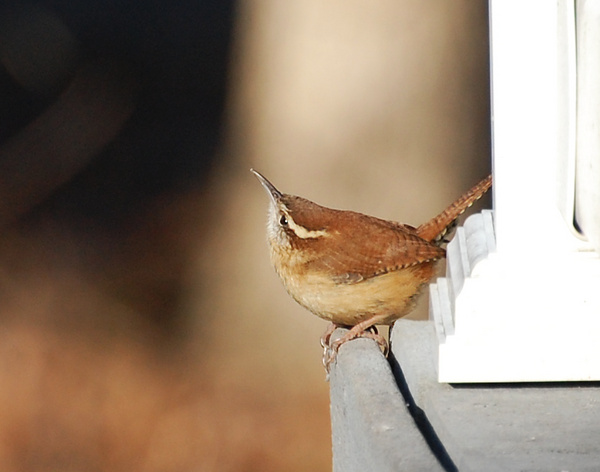
Contrast
May 3rd, 2012
A study in contrast of a Black-Capped Chickadee, red osier dogwood, and blue sky. This is an old photo that I don't think I've shared before.

1680x1050 wallpaper
Ethics of recorded bird calls
May 1st, 2012
I found this article to be a very informative guide on the ethics of bird call playback. I'm heartened to hear that no research has shown damage to breeding bird populations. My fear, that I might accidentally convince a bird to give up and desert its nesting grounds, appears unfounded. It seems that the worst that can happen is a breeding male can "lose face" with his neighbors and/or mate--and only in the case of aggressive (loud and prolonged) playback, where they will perceive him as the loser and the phantom rival as the winner.
Billing and cooing
April 29th, 2012
I've always found female Wood Ducks have a gentle, contented look about them. This one looked especially contented as her mate preened her head to toe.


Rainbow crested
April 27th, 2012
Some very tame Wood Ducks have been hanging out at the north end of Mud Lake, near Cassels Road. Someone must be feeding them--the species is normally quite skittish. Whatever the reason, it's a photographer's dream come true!

1680x1050 wallpaper

1680x1050 wallpaper
Aquatic snail is my best guess. Ducks can swallow them whole, and leave it to their gizzard to break the shell open.

1680x1050 wallpaper
On rare occasions, I see a male Wood Duck with his crest poofed out instead of slicked back. I only ever see it in spring, so it must be intended to impress the ladies.
Spring migrants tough it out
April 26th, 2012
Our recent cold snap has been hard on the birds and butterflies that poured into Ottawa early, drawn by the deceptive summery weather. The many Yellow-Rumped Warblers at Mud Lake yesterday morning were mostly foraging on ground, scraping the bottom of the barrel in their search for insects and other invertebrates. Still, the males had enough energy to sing almost constantly.

Ruby-Crowned Kinglets too filled the air with their songs, and flashed their (normally concealed) ruby crowns at each other. Neither species breeds at Mud Lake, but birds often sing and display in spring migration--warming up, as it were.
Cold weather is ideal for photographing Ruby-Crowned Kinglets. They don't move around as fast!

Spring fever
April 22nd, 2012
It's been an interesting spring.
I haven't been racking up nearly the kind of yearlists as many of my birding acquaintances. I've been hearing more than I see of late. I have, however, had some neat experiences, including exploring some niches of Ottawa greenspace that I never knew about before.
One is the woods behind Nortel, to which I was introduced thanks to Gillian. I went there this afternoon with Michael and had an almost-lifer. We heard a loud, penetrating "kerlee!" coming from within a cattail marsh. I was able to confirm my suspicion when I got home: it was a sora, a type of rail, and one of the very few non-rare breeding birds in Ottawa that I have yet to lifelist. We watched and waited for some time, but without some means to draw him out of the marsh (like an IPod with a sora call on it), it was a lost cause. The cattails were just too thick.
More marshy excitement occurred later, alone. I was exploring Shirley's Bay, hiking a trail I'd never been on before, when I heard the telltale sound of winnowing snipe. (Yes, snipe are real, not just fictitious targets of "snipe hunts"!) These wetland birds perform an aerial courtship display, circling in the air as their wings make a distinctive sound. I followed the sound, and came to a marsh where I was also treated to the scratchy "kiddick kiddick" of a Virginia Rail and the unmistakable deep gurgling "poomp-a-loomp" of an American Bittern. It seemed about the most birdy marsh I'd ever found in Ottawa, in terms of diversity. Of course, it helped that I was there in the evening on an overcast day, as marsh birds tend to be nocturnal, but I'd been to the boardwalks at Stony Swamp many times at dusk and dawn, and never heard so much activity at once. I could only enjoy it by sound, though. The rail and bittern were well-hidden in last year's cattails, and the snipe, I guess, blended into the overcast sky.
Between them and the sora, it really tempted me to turn to the "dark side" and start taking an IPod (or similar) out when I bird. I have ethical qualms about coaxing birds with recorded calls, but with some, they're very hard to see any other way. Still, I enjoyed myself just listening, and my eyes got all the feast they needed when the overcast sky made way for a gorgeous sunset.
As I was walking down Rifle Road to my car, sunset trailing off into night, I had my final surprise. A buzzy "peent" sounded repeatedly from the woods beside the road. Then I started hearing more "peent"s, further down the road, and on the other side. I wondered "nighthawk?" at first, but that didn't seem right. If nighthawks were displaying I should be hearing the whooshing of wings, like I did in Okanagan, and the peents should be coming from the sky, not down in the woods. Besides: it's a little early. The birds that return to Ottawa in April are those that, while they may be partly or even primarily insectivores, can get by on other food if needed. Yellow-Rumped Warblers and Tree Swallows can eat berries. Pine Warblers can eat seeds from pine cones. Nighthawks eat flying insects. Period.
So I decided the peenters must be crickets or somesuch, and walked on. Then something twigged. Specifically this:
That was it. I was hearing woodcocks! Soon after I realized that, the air began to fill with twittering sounds, all up and down Rifle Road. Like snipe, woodcocks do flight displays in spring, but instead of winnowing, their wings chirp like a calling songbird. (Go to near the end of the video to hear it.)
In retrospect it was not a big surprise:
This common breeder is found in appropriate habitat from March to November. Easiest to find in April, when it does its fabulous mating flight from its chosen woodland opening or edge area. Check Shirley's Bay or March Valley Road (Fourth Line) - Klondike at dusk in spring, listening for the twittering flight "song" (really tail-feathers) or the repeated "peent" given when it returns to the chosen spot on the ground.But a treat for me, because while I'd read about woodcock spring fever many times, this was the first time I'd experienced it for myself.
- http://www.neilyworld.com/neilyworld/where.htm
It was really dark by then, but one of the peents sounded no more than ten feet from the road, so I focused my binoculars and scanned the ground. I found him--a shadowy figure, visible only when he moved. I almost couldn't credit what I thought I was seeing. But then the shadow took off suddenly, and I heard the chirping of its wings as it circled overhead. That's when I knew for certain. My first woodcock sighting of spring, and only my second ever. They are furtive, well-camouflaged birds, nigh impossible to find outside of spring display, unless you happen to flush one by walking right next to it (which is how I got my first.)
It struck me how, If I had just been driving my car down Rifle Road with the windows up, all this would have been going on around me and I'd have been none the wiser.
An invasion of Red Admirals
April 17th, 2012
They're everywhere right now!

1680x1050 wallpaper

1680x1050 wallpaper
Birds Of Dutch Gap
January 31st, 2012
The Dutch Gap marshes were, as usual, teeming with wintering waterfowl. None came close enough for artistic photos, but I wanted to take one just to show the variety. Here it is. A sharp-eyed birder should be able to pick out six different species in this picture. (Three more--Northern Pintail, American Wigeon and Wood Duck--were too far away to get in the frame.)

1680x1050 wallpaper
A pair of Double-Crested Cormorants loafing over the James River. I liked getting the chance to capture their deep blue-green eyes.

Hermit Thrush

1680x1050 wallpaper
This juvenile Bald Eagle circled directly over me several times before flying away. It almost seemed like he was trying to decide if I was small enough to carry off and eat! Bald Eagles look more or less like this for four years before they acquire their famous all-white head and tail.
Virginia backyard birds
January 27th, 2012
For this post I owe thanks to my aunt Alice. Her house is surrounded by woods, and she maintains a diversity of feeders in her front and back yards: sunflower, nyjer, mixed seed, multiple suet blocks. I got some of my best photos of the trip just staking out on her back porch.

1680x1050 wallpaper
Tufted Titmouse: the bird that makes everyone go "d'awww!"

My first-ever decent shot of a male Eastern Bluebird. The species is often quite shy.

Carolina Wren
We were sitting in the living room talking when a Red-Bellied Woodpecker came to the suet block hanging just outside the window. I crept up to the glass to photograph him. Feeders are one of the best places to see this species up close. In their natural habitat they usually stay high up in the trees.

The Red-Shouldered Hawks of Deerfield
January 25th, 2012
For the third year in a row, I've found a pair of Red-Shouldered Hawks wintering in a particular spot in my parents' neighborhood. The locals are even familiar with them now, asking me if I'm looking for "the hawks" when I walk by with my binoculars. This time I was able to get good photos of one of them.


They seem to be filling the niche typically filled by accipiters (Sharp-Shinned and Cooper's Hawks) in Ottawa: namely, preying on suburban backyard birds. The one pictured was taking the rather cheeky approach of perching directly above a feeder.

1680x1050 wallpaper
The classic watchful pose of the Northern Mockingbird. As it happens, this bird was in the same yard as the hawk, so he had good reason to be watchful!
|
